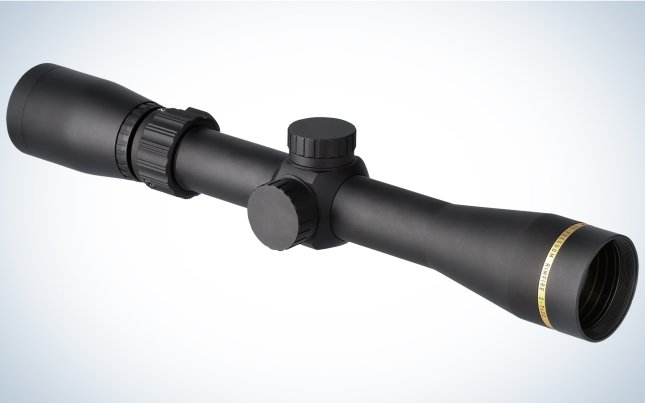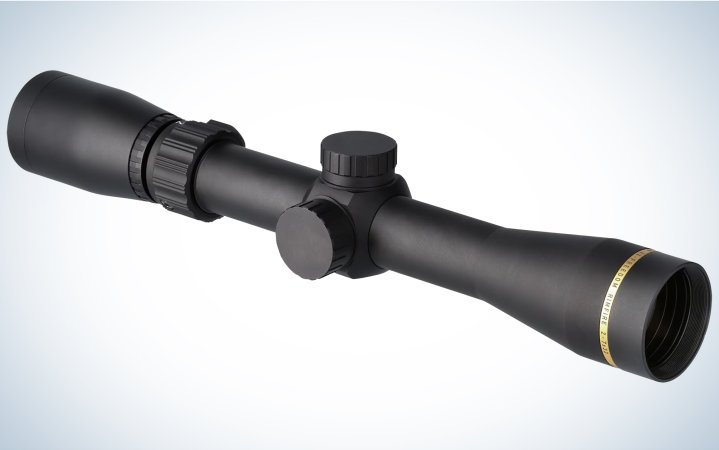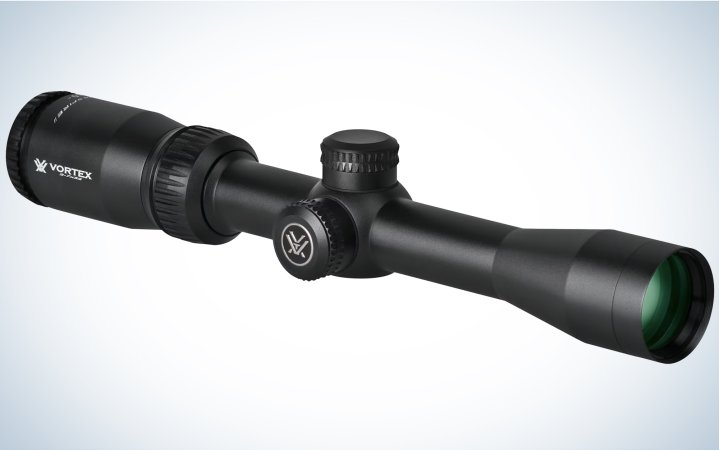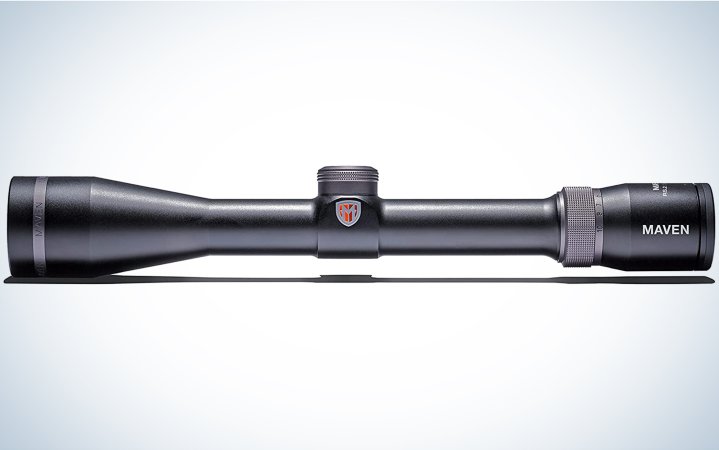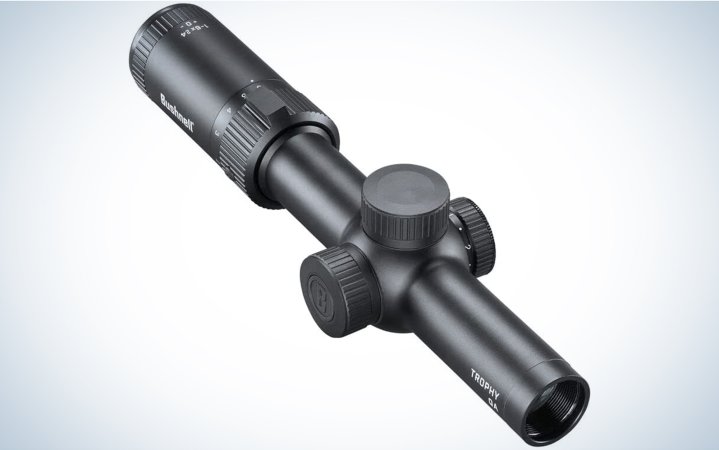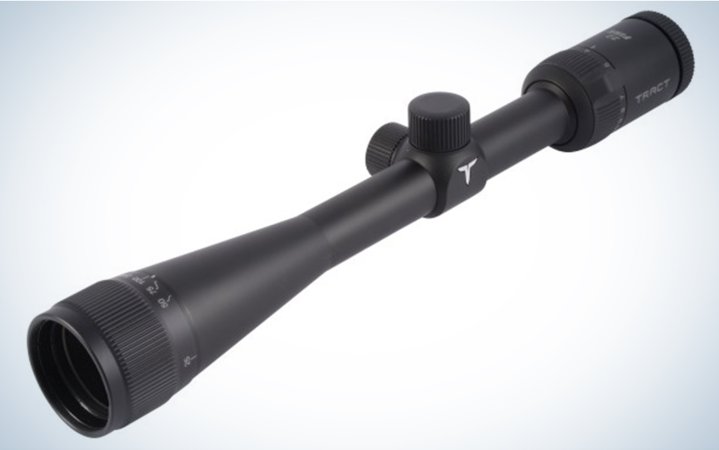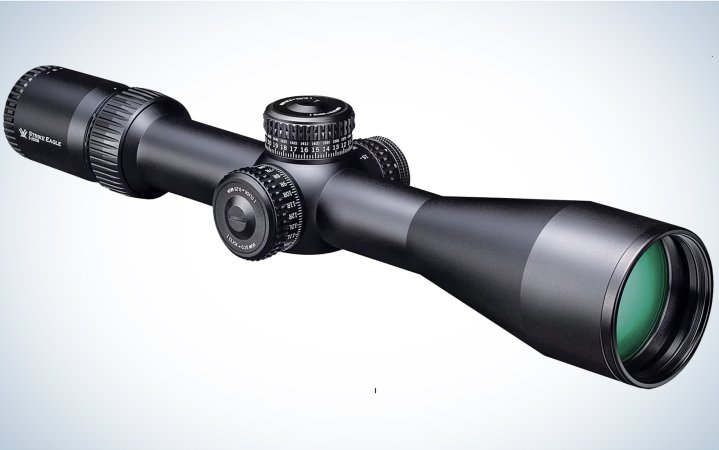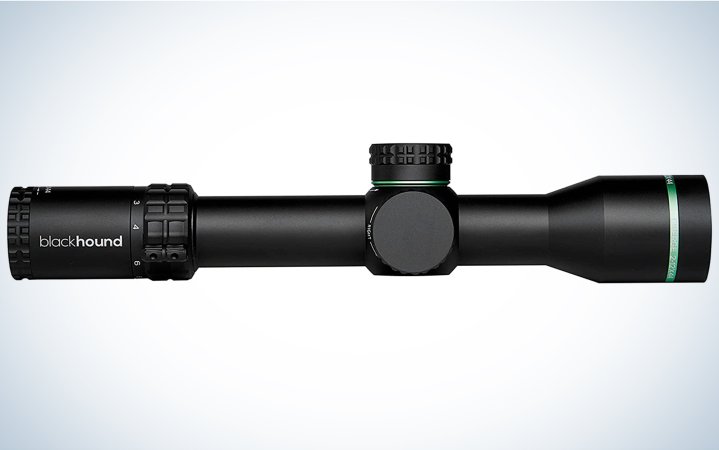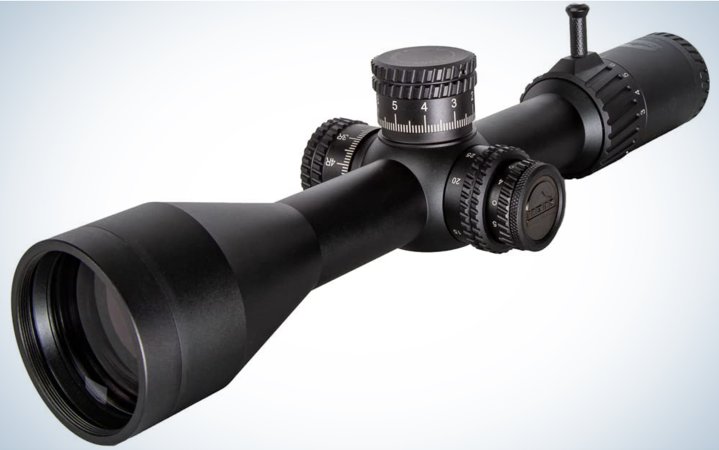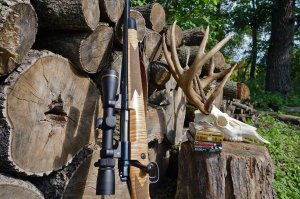We may earn revenue from the products available on this page and participate in affiliate programs. Learn More ›
Between small-game rifles and precision target rigs, short-range plinkers, and rimfire ARs, there’s a .22 for every shooter and use, and every one of them needs a scope. The optics industry has answered the call, and you can find a scope for just about any rifle. Here are some of the best rimfire scopes on the market. You’ll notice, though, that these aren’t all your standard low-mag variable models. You’ll see some high-end precision scopes here as well as LPVO (low-power variable optics) that are designed for close-quarters AR and shotgun work but also make marvelous rimfire optics for either hunting or punching targets.
- Best Overall: Leupold VX-Freedom 2-7×33
- Best Traditional: Vortex Crossfire II 2-7×32
- Best Crossover Hunting Scope: Maven RS.2 2-10×38
- Best Small-Game Hunting Scope: Bushnell Trophy Quick Acquisition 1-6x24l
- Best Second-Plane Target Scope: Tract 22 FIRE 4-12×40
- Most Versatile: Athlon Argos HMR 2-12×42
- Best Full-Size Precision Scope: Vortex Strike Eagle 5-25×56 FFP
- Best Precision Rimfire Scope: Blackhound Emerge 2-12×44 MIL
- Best Precision Scope Under $400: Sightmark Presidio 3-18×50 LR2
- Best LPVO: EOTECH Vudu 1-10×28
- Best .22 Magnum Rifle Scope: Hawke Vantage IR 4-12×40 AO
How I Chose the Best Rimfire Scopes
Some of the scopes in this roundup are new for 2022 and were included in the rigorous evaluations of Outdoor Life’s annual optics test. For those, I measured optical resolution on my resolution range, scored low-light performance against their peers, and measured the precision and repeatability of the reticle and turrets. But some scopes in this collection were not in the test, and I evaluated those by mounting them to my collection of .22 trainers and shot them on both paper and steel targets at various distances, evaluating their handling, reticles, and overall precision and speed.
I rated each scope on its ability to perform a series of shooting tasks, engaging targets at 20 yards, then at 50, and out to 100. I also used both reticle references and the turrets to make shots out to 350 yards, but this was more a test of “close-enough” than precision.
For each scope, I make a subjective determination of optical quality, looking for distortions, optical aberrations, and any distracting jags of light. And I determine how quickly and precisely I can use the reticle. Lastly, I assessed the extras, including the accessories that it ships with and each submission’s warranty.
The Best Rimfire Scopes: Reviews and Recommendations
Best Overall: Leupold VX-Freedom 2-7×33
Pros
- Excellent glass and coatings
- MOA-based references are simple and clear
- Low-profile mounting dimension
- Wide versatility
- Catchy turret graphics
Cons
- Reticle lacks windage references
- Parallax fixed at 100 yards
- Turret clicks are mushy
Key Features
- Weight: 11.1 ounces
- Magnification Range: 2-7-power
- Objective Lens Diameter: 33mm
- Tube Diameter: 1-inch
- Turret Click Values: .25 MOA
- Total Elevation Adjustment: 75 MOA
- Reticle Focal Plane: Second
- Illuminated Reticle: No
Why It Made The Cut
Combining simple controls and a modest but versatile magnification range, this durable scope is perfect for just about any .22 or .17, whether for small-game hunting, plinking, or most precision target work. It has good glass, repeatable controls, and enough holdover references on the vertical stadia that, with some practice, you can extend your range out to 100 yards and longer. At close to $300, it’s priced in the meaty middle of the market and can easily transition from a first-gun optic to just about any other rifle, whether a rimfire or not.
Here’s a rimfire scope for just about any purpose. This outwardly pedestrian optic has a lot going on between a surprisingly precise second-plane reticle, bright glass, and fun indexing on the nicely tactile turrets. The best thing you can say about any scope is that it is consistent, and the VX-Freedom delivers bullets with pleasing reliability. It’s a good rabbit and squirrel scope. Still, the MOA-based references on the vertical crosshair make it a decent option for engaging distant targets, which means you don’t have to invest in a ponderously big first-plane target scope to take titles at NRL22 competitions. Lastly, the Leupold rimfire scope brings the company’s good glass and an excellent warranty.
Read Next: The Best Rifle Scopes
Best Traditional: Vortex Crossfire II 2-7×32
Pros
- Long eye relief
- Appealing price
- Low-profile mounting dimensions
- Simple reticle
- Excellent warranty
- Parallax fixed at 50 yards
Cons
- Reticle lacks windage or elevation references
- Limited focus control
Key Features
- Weight: 13.9 ounces
- Magnification Range: 2-7-power
- Objective Lens Diameter: 32mm
- Tube Diameter: 1-inch
- Turret Click Values: .25 MOA
- Total Elevation Adjustment: 60 MOA
- Reticle Focal Plane: Second
- Illuminated Reticle: No
Why It Made The Cut
There’s not much innovative or surprising here, just a basic duplex reticle inside a straight-ahead scope with decent turrets and a durable build. Backed by an excellent warranty.


If simplicity is the pathway to versatility, then the Vortex Crossfire II is at home on a small-game bolt rifle or a fast-shooting AR. It might not have the chops for precision work, but the duplex reticle is fast and reliable. The controls are a little mushy, but the eye relief and eye box are both forgiving and the fixed parallax makes it a great plinking scope. Basically, any tin can or cottontail inside 50 yards is in trouble.
Best Crossover Hunting Scope: Maven RS.2 2-10×38
Pros
- Light and compact
- SHR reticle has (limited) elevation references
- Utility extends to center-fire scopes
- Liberal mounting dimensions
- Excellent glass and coatings
Cons
- No windage references
- Slightly spongy turret dials
Key Features
- Weight: 12.4 ounces
- Magnification Range: 2-10-power
- Objective Lens Diameter: 38mm
- Tube Diameter: 1-inch
- Turret Click Values: .25 MOA
- Total Elevation Adjustment: 50 MOA
- Reticle Focal Plane: Second
- Illuminated Reticle: No
Why It Made The Cut
This is a fun-sized optic with excellent controls and glass and a bright, light, and durable scope that’s a good fit for a rimfire or ultralight bolt-action build.
Excellent glass, velvety controls, and a reticle that offers just enough holdover references for precision work, this is a scope that’s at home on a lightweight mountain rifle or a bespoke squirrel sniper. The RS.2 is available in either a bold duplex or SHR reticle—I recommend the latter for more references (three elevation holds; no wind holds). That probably has more utility for big-game hunters than for .22 shooters, but the holdovers are pretty handy for making shots beyond zero range.
At about $550, this direct-to-consumer optic is a little pricey for a basic second-plane rimfire scope, but Maven brings elegance, brilliant Japanese glass, and sweet turret controls to the game. The low-profile objective and the magnification range make it a very good choice for a special rimfire rifle.
Read Next: The Best .22 LR Rifles
Best Small-Game Hunting Scope: Bushnell Trophy Quick Acquisition 1-6x24l
Pros
- Low-profile mounting dimension
- Extremely fast on target
- “Dot Drop” reticle has good holdover references
- 6-step illumination
- Compatible with shotguns and ARs
- Wide field of view
Cons
- Reticle lacks full precision references
- Some peripheral distortion
Key Features
- Weight: 18 ounces
- Magnification Range: 1-6-power
- Objective Lens Diameter: 24mm
- Tube Diameter: 30mm
- Turret Click Values: .5 MOA
- Total Elevation Adjustment: 140 MOA
- Reticle Focal Plane: Second
- Illuminated Reticle: Yes
Why It Made The Cut
This was the most fun scope in our test. A quick, precise, extremely nimble low-power optic, it gets on target quickly but has enough reticle references for longer-distance work.
This is the scope that small-game hunters have been waiting for. It’s fast, keeping up with running rabbits, and its “Dot Drop” reticle in the second focal plane pops against just about any background. The Trophy Quick Acquisition has a very precise illuminated center dot for precise bullet placement or for fast target acquisition, and its holdover references (there’s a hash every 2 MOA) allows you to drop bullets into targets at a distance. The 1-6-magnification handles just about any shooting situation, from close-in game and steel to out-there targets. Besides its technical attributes, it’s simply fun to shoot. The controls are responsive, the glass is good enough, and it mounts low enough that bringing it to your eye is as intuitive as pointing your finger. Best part: It’s priced under $200.
Best Second-Plane Target Scope: Tract 22 FIRE 4-12×40
Pros
- Excellent focus control, 10 meters to infinity
- Extremely tactile turret controls
- Long eye relief
- Liberal mounting dimensions
Cons
- Focus on objective is clunky
- Extremely tight power ring
Key Features
- Weight: 16 ounces
- Magnification Range: 4-12-power
- Objective Lens Diameter: 40mm
- Tube Diameter: 1 inch
- Turret Click Values: .25 MOA
- Total Elevation Adjustment: 60 MOA
- Reticle Focal Plane: Second
- Illuminated Reticle: No
Why It Made The Cut
A purpose-built rimfire scope, the second-plane reticle features a MOA-based dot for precise aiming solutions.


Tract’s 22 FIRE series has a full series of scopes for .22 and .17 shooters, but this AO model (it stands for Adjustable Objective) is the most versatile scope in the line from the direct-to-consumer brand. The duplex reticle features a fine crosshair with a .25 MOA center dot, which allows for full view of the target and precise bullet placement, which competitive bullseye target shooters will appreciate.
The adjustable objective enables precise focus for targets inside 10 yards all the way out to infinity, a feature you don’t often see on rimfire-specific scopes. The objective focus is a little clunky compared with the side parallax of most modern scopes, but it works well and further enables precise shooting. At about $275 it’s not a cheap scope, but the glass is good, the controls are some of the best in the business, and the precision it allows also makes it a killer squirrel scope.
Most Versatile: Athlon Argos HMR 2-12×42
Pros
- Versatile magnification range
- Illuminated reticle
- Side focus
- Capped turrets
- Good warranty
Cons
- Underwhelming glass
- Controls are mushy
- Limited mounting dimensions
Key Features
- Weight: 19.8 ounces
- Magnification Range: 2-12-power
- Objective Lens Diameter: 42mm
- Tube Diameter: 1-inch
- Turret Click Values: .25 MOA
- Total Elevation Adjustment: 130 MOA
- Reticle Focal Plane: Second
- Illuminated Reticle: Yes
Why It Made The Cut
This second-plane middle-of-the-road scope isn’t built for any specific task. Instead, it does a pretty good job at any shooting situation, whether mounted on a center-fire big-game rifle, a rimfire, an AR, or even a mid-range platform like a straight-wall carbine or slug gun.
Priced at about $450, this Athlon has more features than most scopes at this price point. Its best attribute is side parallax control that brings targets as close as 10 yards into sharp focus, a feature that’s useful for rimfire shooters who are often engaging close-in and far-out targets. The illumination is also worth a look. The second-plane scope is available with a standard duplex reticle, but opt for the BDC 600A reticle, which gives shooters holdover hashes out to 600 yards when the scope is on its highest power. The glass in the Argos HMR isn’t the best, but for most shooting situations, it will provide a decent image and capably guide bullets of just about any caliber. The best attribute for a rimfire shooter is that this scope can easily be swapped out to just about any other rifle, making it a good all-around optic.
Best Full-Size Precision Scope: Vortex Strike Eagle 5-25×56 FFP
Pros
- Huge magnification range
- Competition reticle
- Side focus, 15 yards to infinity
- Pull-to-turn tactical turrets
- Good warranty
Cons
- Underwhelming glass
- Controls are mushy
- Overkill for most rimfire applications
Key Features
- Weight: 30.4 ounces
- Magnification Range: 5-25-power
- Objective Lens Diameter: 56mm
- Tube Diameter: 34mm
- Turret Click Values: .25 MOA
- Total Elevation Adjustment: 110 MOA
- Reticle Focal Plane: First
- Illuminated Reticle: Yes
Why It Made The Cut
A big, serious precision scope with attributes for any long-distance target work, whether rimfire or PRS center-fire rifles.
Okay, I realize this isn’t your standard rimfire optic. It’s purpose-built for the 1,000-yard-and-longer center-fire steel-plate crowd. But the Strike Eagle has an extremely useful reticle for almost every rimfire competition, from punching paper at known distances to engaging steel silhouette targets and all the crazy shooting situations in the NRL22. Attributes that make it a worthy rimfire consideration: close-focus to 15 yards, a nicely illuminated first-plane reticle, holdover hashes at every MOA and windage dots out to 24 MOA, and nicely indexed turrets. All this for well under $1,000. The best argument for consideration: learn to shoot this reticle on a cheap and fun rimfire trainer, then graduate up to a center-fire chassis rifle.
Best Precision Rimfire Scope: Blackhound Emerge 2-12×44 MIL
Pros
- First-plane tree-style reticle
- Capped low-profile turrets
- Ships with rings and levels
- Zero stop
- 6-step illumination
- 10 MILs of holdover references
Cons
- Ponderously big
- Fairly expensive
Key Features
- Weight: 29.1 ounces
- Magnification Range: 2-12-power
- Objective Lens Diameter: 44mm
- Tube Diameter: 34mm
- Turret Click Values: .1 MRAD
- Total Elevation Adjustment: 30 MIL
- Reticle Focal Plane: First
- Illuminated Reticle: Yes
Why It Made The Cut
A ton of scope for almost any rimfire competition, it’s a great training platform to take this optic to NRL and Precision Rifle shoots.
Go back and read the rationale for this scope under the Vortex Strike Eagle spot. All those arguments go double for this big, serious precision scope from a new direct-to-consumer brand. The main argument for a rimfire shooter is that if you can learn to shoot well and quickly with this first-plane reticle on a .22 trainer, then you’ll be miles ahead of your peers when you strap it on a long-distance center-fire precision rifle. The Blackhound has fine glass, very tactile low-profile turrets, and a side focus control that brings targets as close as 10 yards into crisp focus. It’s pricey, around $1,150, but there’s a whale of a lot of value in this scope that has a magnification range that is way more useful than the standard 5-25-power of most precision target scopes.
Best Precision Scope Under $400: Sightmark Presidio 3-18×50 LR2
Pros
- First-plane tree-style reticle
- Exposed tactical-style turrets
- Throw lever
- Zero stop
- 6-step illumination
- 25 mils of internal adjustment
Cons
- Disappointing glass
- Ponderously big for hunting
- Limited warranty
Key Features
- Weight: 30.8 ounces
- Magnification Range: 3-18-power
- Objective Lens Diameter: 50mm
- Tube Diameter: 30mm
- Turret Click Values: .1 MRAD
- Total Elevation Adjustment: 26 MRAD
- Reticle Focal Plane: First
- Illuminated Reticle: Yes
Why It Made The Cut
The rare long-distance precisions scope that retails for under $400, this feature-packed option from Sightmark will get shooters of just about any budget and caliber ringing steel.
Shooters with a limited budget should give their attention to this full-featured precision scope from Sightmark that retails for around $400. The Presidio has everything that the major brands offer shooters, from a very capable first-plane reticle with plenty of elevation and windage references, oversized exposed turrets to make field adjustments easy, and a zero-stop that allows shooters to return to their zero without tools.
Other noteworthy features for rimfire shooters include a 10-yard-to-infinity focus, 6-step illumination, and reticle holds with 10 MILS of drop and 6 MILS of wind hold. How does Sightmark deliver so much utility for such an accessible price? The glass is flinty and shows lots of optical aberrations. You can expect to get some flaring and peripheral distortion. However, the center of the lens—where most shooters spend most of their time—is clear and sharp. In a field with mostly second-plane, hunting-style scopes, this is a full-featured standout that won’t cost a bunch.
Best LPVO: EOTECH Vudu 1-10×28
Pros
- Monster magnification range
- Dual-purpose tactical reticle
- Push-button illumination module
- 10 reticle illumination intensity settings
- References for long-distance work
- Pull-to-turn elevation dial
Cons
- Wildly expensive
- 34mm tube is bulky
Key Features
- Weight: 21.3 ounces
- Magnification Range: 1-10-power
- Objective Lens Diameter: 28mm
- Tube Diameter: 34mm
- Turret Click Values: .1 MRAD
- Total Elevation Adjustment: 29 MRAD
- Reticle Focal Plane: First
- Illuminated Reticle: Yes
Why It Made The Cut
A full-featured Low Power Variable Optic with enough features for small-game hunting and rimfire target work.
The first time I shot this extremely versatile scope it was on a tactical AR and I was engaging targets from 10 yards out to 750 yards. All I could think was how fun it would be on a practical .22 course. This is definitely not intended for NRL22 games, but rather is a battle-hardened tactical optic that has caught fire with personal-defense carbine owners. Still, I maintain the EOTECH Vudu has all the attributes you’d ever want for any rimfire action, whether you’re talking about running rabbits, punching holes in paper targets, or running a steel plate course.
The first-plane reticle evolves from a fast and bright red dot at 1-3-power up to a surprisingly detailed precision reticle with aiming points for distant targets from about 7-power up to 10-power. The illumination is bright, and the push-button control is intuitive. The build and turrets are durable enough for anything you can throw at it, and the Japanese glass is bright and crisp. The main downside is its $1,800 price tag. But at that price, you can switch it to just about any rifle in your collection.
Read Next: Best Budget LPVO
Best .22 Magnum Rifle Scope: Hawke Vantage IR 4-12×40 AO
Pros
- Holdover references tuned to .22 WMR
- Objective-bell focus
- Nice illumination
- Good magnification range
- Capped turrets
Cons
- Stingy mounting dimensions
- Reticle utility is limited to WMR
Key Features
- Weight: 18.1 ounces
- Magnification Range: 4-12-power
- Objective Lens Diameter: 40mm
- Tube Diameter: 1-inch
- Turret Click Values: .25 MOA
- Total Elevation Adjustment: 80 MOA
- Reticle Focal Plane: Second
- Illuminated Reticle: Yes, red and green
Why It Made The Cut
A bright, light, and durable scope with a second-plane reticle configured for the ballistics of the .22 Winchester Magnum.
If you’re a .22 WMR shooter, this is your scope. The reticle has drops for bullets with muzzle velocities of 2,000 fps. With a 100-yard zero, you can drop rounds with pleasing consistency out to 300 yards with the second-plane BDC reticle and the scope on its highest power. Suppose you want to use a lower magnification, or bullets with different velocities. In that case, you’ll have to experiment on the subtensions, but it’s a pretty handy feature for a rimfire optic. The Hawke has good glass, decent controls, and the illumination is a nice feature. But the attribute that also makes this a great rimfire scope is the focus control located on the objective bell. You can bring targets into focus as close as 10 yards and out to infinity.
Things to Consider Before Buying a Rimfire Rifle Scope
Your first consideration if you’re in the market for a rimfire rifle scope is how well it will perform with the short-range capabilities of the caliber. You probably don’t need a ton of magnification or reticle references if all you want is to shoot tin cans or 50-meter bullseye targets. But the world of rimfire shooting is evolving to look a lot like long-distance center-fire precision shooting, with all sorts of precision rimfire competitions and games that put a premium on both short-range and long-range precision. For backyard plinkers, you probably just want a simple scope with a duplex reticle, but for the latter, you’re going to want a first-plane reticle with lots of turret adjustment. Then there are the pure small-game scopes. These are lower-magnification optics with just enough reticle references to get you on game and maybe make longer shots, head-shooting squirrels, for instance.
FAQs
For small-game hunting, I want a scope that gets on target fast, has a reticle that “pops” from the background, but has enough references for me to place bullets precisely out to about 75 or 100 yards. In this collection, the standout hunting scope is Bushnell’s Trophy Quick Acquisition (QA), a 1-6×24 marvel that points quickly, has an illuminated center dot for low-light work, and enough holdover references for longer shots. Others worth a look: Vortex’s Crossfire II, and Tract’s 22 FIRE. At the other end of the spectrum is EOTECH’s expensive 1-10×24 Vudu, which doubles as a marvelous AR optic. Or consider Leupold’s VX-Freedom. Its simple duplex reticle is fast and reliable.
I like lower-power scopes for most rimfire work, whether that’s hunting or target shooting. A 2-7-power or even 1-8-power will give you all the magnification you need for most purposes. But if you’re interested in the precision rimfire competitions, then you’re going to want more magnification to really see the nuances of distant targets. For those times, I’d go with a 5-20-power or 4-16-power range, and make sure that precision target scopes also have manual focus—often called parallax—to bring targets of whatever distance into crisp focus.
The price of rimfire scopes ranges all the way from about $100 up to nearly $2,000. There are problems with both ends of that spectrum, just as there are great deals as long as you know what attributes you want and how you’ll use the scope. Starting at the lower end of the price spectrum, I’d be a little leery of super-cheap scopes, simply because they are probably made with substandard components and may not be as durable as higher-priced models. If you spend under $100 on a scope, make sure it has a good warranty that will cover any breakage or malfunctions.
But you can buy a lot of scope for under $200. Scopes in this roundup include Bushnell’s Trophy QA and Vortex’s Crossfire II, and both the Leupold VX-Freedom and Tract’s 22 FIRE AO are both priced around $300 and offer excellent durability, utility, and warranties. Precision rimfire scopes can be especially expensive, largely because their precision controls and components are built to a higher standard. Still, the Sightmark Presidio, priced under $400, and the Vortex Strike Eagle are both worth looking at for budget precision options. On the other end of the spectrum, both the EOTECH Vudu and Blackhound Emerge offer tons of precision for rimfire shooters, but have all the attributes to transition once you move up to center-fire precision target shooting.
Final Thoughts on the Best Rimfire Scopes
Somehow, the optics industry has squeezed all the fun out of rimfire shooting. Instead of cheap, reliable, and utilitarian rifles, we now have fancy chassis rifles with all the attributes of their big-bore brethren. And prices to match. We’ve complicated what was once the most fun and simple type of shooting into rigorous competition. That’s all great if you want to make .22 shooting into a serious thing, but don’t forget that rimfires are the gateway for most shooters and hunters into our community, and the scopes and rifles that are the best for new shooters are often the most simple and cheap. So read this review with a little bit of skepticism. There are optics for every stage in a shooter’s evolution, but maybe pay special attention to those fun, simple, gateway scopes.
- Best Overall: Leupold VX-Freedom 2-7×33
- Best Traditional: Vortex Crossfire II 2-7×32
- Best Crossover Hunting Scope: Maven RS.2 2-10×38
- Best Small-Game Hunting Scope: Bushnell Trophy Quick Acquisition 1-6x24l
- Best Second-Plane Target Scope: Tract 22 FIRE 4-12×40
- Most Versatile: Athlon Argos HMR 2-12×42
- Best Full-Size Precision Scope: Vortex Strike Eagle 5-25×56 FFP
- Best Precision Rimfire Scope: Blackhound Emerge 2-12×44 MIL
- Best Precision Scope Under $400: Sightmark Presidio 3-18×50 LR2
- Best LPVO: EOTECH Vudu 1-10×28
- Best .22 Magnum Rifle Scope: Hawke Vantage IR 4-12×40 AO

